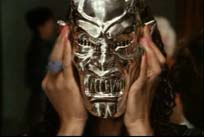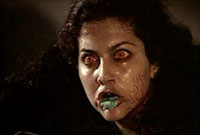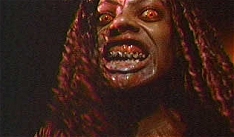
 Few
movies have as regal a horror pedigree as "Demons." Director
Lamberto Bava is the son of Italian master Mario Bava ("Black Sabbath",
"A Bay of Blood", and countless others) so he brings high expectations
to the table. His writing partner on "Demons" is no less than
Dario Argento! Italian Horror fans will no doubt know Argento from his
string of back-to-back classics from the 1970's "Suspiria",
"Inferno", and "Tenebre" and from his earlier giallos.
Together Bava and Argento created a one of the most popular horror films
of the eighties. "Demons" takes the greatest aspects of Italian
horror, mixes it in with influences Romero's excellent "Living Dead"
series, and combines them both with early 80's heavy metal (both music
and attitude) to make an experience that is quite different from the cookie-cutter
horror that was prevalent at the time.
Few
movies have as regal a horror pedigree as "Demons." Director
Lamberto Bava is the son of Italian master Mario Bava ("Black Sabbath",
"A Bay of Blood", and countless others) so he brings high expectations
to the table. His writing partner on "Demons" is no less than
Dario Argento! Italian Horror fans will no doubt know Argento from his
string of back-to-back classics from the 1970's "Suspiria",
"Inferno", and "Tenebre" and from his earlier giallos.
Together Bava and Argento created a one of the most popular horror films
of the eighties. "Demons" takes the greatest aspects of Italian
horror, mixes it in with influences Romero's excellent "Living Dead"
series, and combines them both with early 80's heavy metal (both music
and attitude) to make an experience that is quite different from the cookie-cutter
horror that was prevalent at the time.
The plot of
"Demons" is both inventive and original without being implausible.
Random people on the street are approached by a man in a menacing silver
mask and given tickets to a film playing that night at the Metropol Theatre.
Creating suspense out of seemingly mundane events is a trick Argento borrowed
from his idol and primary influence, Hitchcock. As we see through the
course of the film, these free tickets come a high price to the recipients.
This macabre twist on the "golden ticket" from "Willie
Wonka and the Chocolate Factory" is used to question the nature of
these seemingly random events.
One of the
most philosophically challenging questions of human existence is "Why?"
This question is a primary theme in all horror films: "Why is this
happening to me?" The characters in "Demons" are faced
with the question of whether they are there by design or by chance, and
this is an issue for the viewer to delve into as well: Are their eventual
fates the cause of simple bad luck or have they been maliciously singled
out? Your individual decision on this question fundamentally colors the
way you view the characters and respond to their plight. Bava and Argento
have done an excellent job of keeping this area gray. The characters are
a mixed group of seemingly innocent people (the teens) and those whom
the viewers would judge as outside the norm (the pimp and his girls).
 Once
in the theatre, one of the girls cuts herself on a replica of the silver
mask. Again at first this meaningless activity will become tragic as the
film progresses. At this point the film takes a very post-modern turn
and enters into the realm of a meta-narrative, or a film-within-a-film.
While postmodernism is a staple of art house films it is quite rare to
find it in a horror film, and it gives "Demons" another contextual
level. The film the characters watch begins to slowly parallel and converge
with the events in the character's lives. A group of teens comes across
the tomb of Nostradamus where they find a menacing silver mask, identical
to the one worn by the ticket-giver and the one in the lobby.
Once
in the theatre, one of the girls cuts herself on a replica of the silver
mask. Again at first this meaningless activity will become tragic as the
film progresses. At this point the film takes a very post-modern turn
and enters into the realm of a meta-narrative, or a film-within-a-film.
While postmodernism is a staple of art house films it is quite rare to
find it in a horror film, and it gives "Demons" another contextual
level. The film the characters watch begins to slowly parallel and converge
with the events in the character's lives. A group of teens comes across
the tomb of Nostradamus where they find a menacing silver mask, identical
to the one worn by the ticket-giver and the one in the lobby.
Herein lies the most masterful part of Bava and Argento's film. Once the
on-screen characters discover the mask, the line between the screen and
reality begin to blur. Originally unbeknownst to the patrons of the theatre,
the increasing terror on-screen will soon be acted out in reality in front
of them. One of the film teens puts on the silver mask and begins attacking
and killing the other film teens. Meanwhile, the girl who had cut herself
with the mask begins to make a terrifying transformation into one of the
titular "Demons." Once the killings begin the characters are
faced with the question of fantasy vs. reality. Granted they are probably
too busy fending off demons to think deeply about it, but the question
is raised in viewer's minds.
 Once
the demons arrive the film somewhat makes a shift from these aforementioned
high-minded ideals to a more traditional horror survival theme. While
the remainder of the film is more straightforward, this is not to say
it is without symbolism. The film takes a page directly from George Romero's
1978 "Dawn of the Dead" and pulls it off with a different feel
which prevents the film from being a mere copy. Romero's film examined
consumerism by trapping his characters in a shopping mall. The zombies
lampooned 1970's "Me" generation by behaving in pretty much
the same way living humans do in a mall: riding the escalator, shambling
through aisles. "Demons" examines the motives behind horror
movies. These people in the theatre would have been entertained if the
carnage had been confined to the screen. They wanted to be scared, but
within reason. It puts the horror fans themselves under the microscope
by examining the underlying sadism of enjoying watching someone else go
through these terrors that you yourself would not want to face.
Once
the demons arrive the film somewhat makes a shift from these aforementioned
high-minded ideals to a more traditional horror survival theme. While
the remainder of the film is more straightforward, this is not to say
it is without symbolism. The film takes a page directly from George Romero's
1978 "Dawn of the Dead" and pulls it off with a different feel
which prevents the film from being a mere copy. Romero's film examined
consumerism by trapping his characters in a shopping mall. The zombies
lampooned 1970's "Me" generation by behaving in pretty much
the same way living humans do in a mall: riding the escalator, shambling
through aisles. "Demons" examines the motives behind horror
movies. These people in the theatre would have been entertained if the
carnage had been confined to the screen. They wanted to be scared, but
within reason. It puts the horror fans themselves under the microscope
by examining the underlying sadism of enjoying watching someone else go
through these terrors that you yourself would not want to face.
"Demons" is a well-made film that has a lot more artistic merit
than one would expect to find in this type of fare. While the acting performances
left something to be desired, the special effects are top-notch, and we
all know which one is really the "star" in a horror film. I
have heard complaints about some of the more strange elements of the film.
I attribute these to a lack of familiarity with Italian horror and more
specifically Argento's work. The helicopter through the roof scene seems
to be a sticking point for a lot of people. It could symbolize the crashing
down of reality and reinforce the character's dwindling hope of escape,
however Argento is known for throwing oddball things in films just to
unsettle the viewer.
I'll leave you with this: If you're watching a film of someone watching
a film, who is watching you?
Demons (1985)
Directed by Lamberto Bava
Written by Lamberto Bava & Dario Argento
Review by David Carter

Advertise in Savage Cinema • Contact Us
Copyright © 2002-2005 Savage Cinema. All rights reserved.